Business Strategy Report: Vodafone's Competitive Advantage Analysis
VerifiedAdded on 2020/10/05
|21
|5537
|482
Report
AI Summary
This report provides a comprehensive analysis of Vodafone's business strategy. It begins with an introduction to business strategy and Vodafone's position as a leading multinational telecommunications company. The report then delves into a PESTLE analysis of Vodafone's macro environment, considering political, economic, social, technological, legal, and environmental factors. It evaluates the vision, mission, and objectives of Vodafone. The report further analyzes Vodafone's internal environment using a SWOT analysis, identifying the company's strengths, weaknesses, opportunities, and threats. The report also explores frameworks for analyzing the internal environment and capabilities, and discusses the outcomes of macro and micro environment analyses. Finally, it examines the strategies Vodafone can employ to improve its competitive advantage and market position, including the application of Porter's Five Forces model and strategic management planning. The report concludes with a summary of key findings and recommendations.

Business Strategy
Paraphrase This Document
Need a fresh take? Get an instant paraphrase of this document with our AI Paraphraser
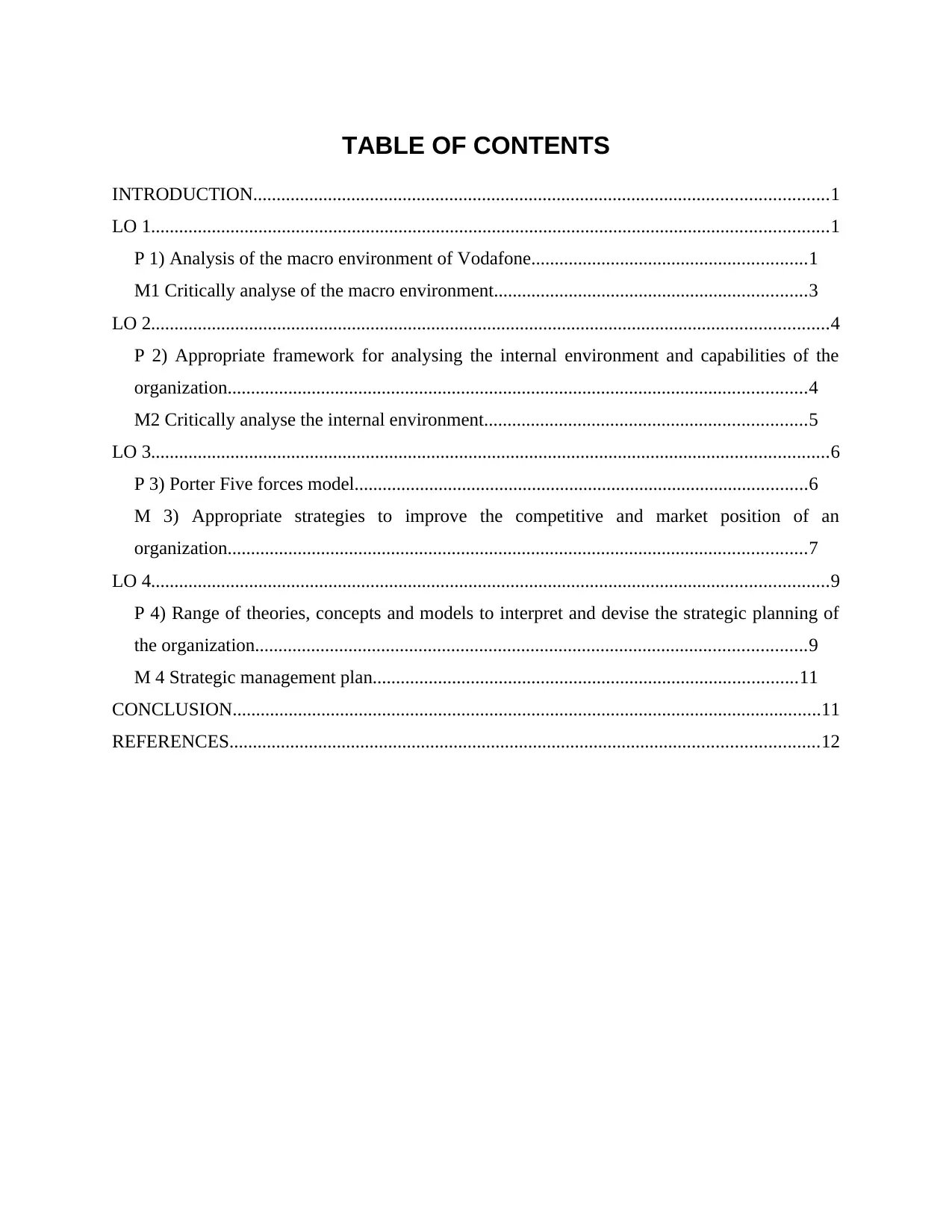
TABLE OF CONTENTS
INTRODUCTION...........................................................................................................................1
LO 1.................................................................................................................................................1
P 1) Analysis of the macro environment of Vodafone...........................................................1
M1 Critically analyse of the macro environment...................................................................3
LO 2.................................................................................................................................................4
P 2) Appropriate framework for analysing the internal environment and capabilities of the
organization............................................................................................................................4
M2 Critically analyse the internal environment.....................................................................5
LO 3.................................................................................................................................................6
P 3) Porter Five forces model.................................................................................................6
M 3) Appropriate strategies to improve the competitive and market position of an
organization............................................................................................................................7
LO 4.................................................................................................................................................9
P 4) Range of theories, concepts and models to interpret and devise the strategic planning of
the organization......................................................................................................................9
M 4 Strategic management plan...........................................................................................11
CONCLUSION..............................................................................................................................11
REFERENCES..............................................................................................................................12
INTRODUCTION...........................................................................................................................1
LO 1.................................................................................................................................................1
P 1) Analysis of the macro environment of Vodafone...........................................................1
M1 Critically analyse of the macro environment...................................................................3
LO 2.................................................................................................................................................4
P 2) Appropriate framework for analysing the internal environment and capabilities of the
organization............................................................................................................................4
M2 Critically analyse the internal environment.....................................................................5
LO 3.................................................................................................................................................6
P 3) Porter Five forces model.................................................................................................6
M 3) Appropriate strategies to improve the competitive and market position of an
organization............................................................................................................................7
LO 4.................................................................................................................................................9
P 4) Range of theories, concepts and models to interpret and devise the strategic planning of
the organization......................................................................................................................9
M 4 Strategic management plan...........................................................................................11
CONCLUSION..............................................................................................................................11
REFERENCES..............................................................................................................................12
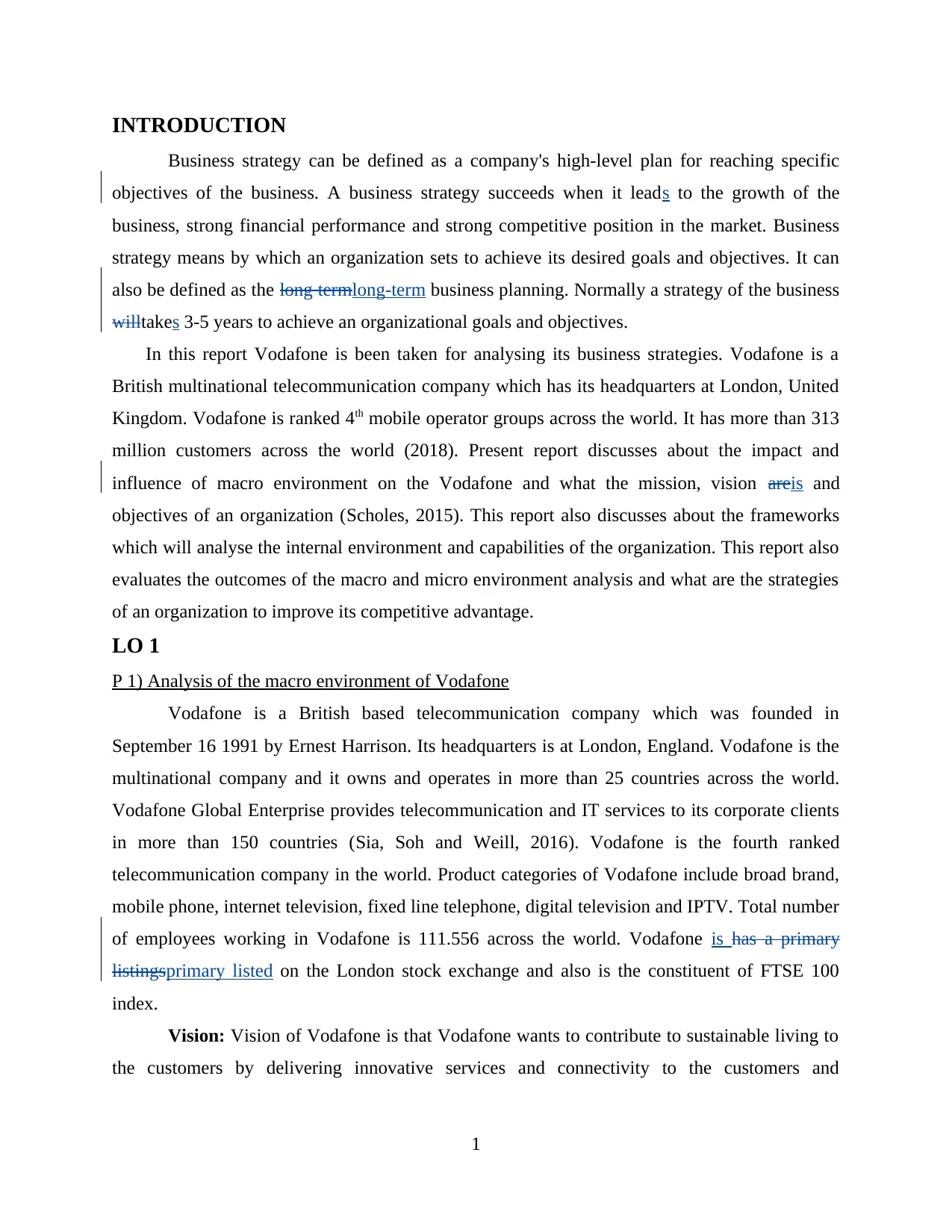
INTRODUCTION
Business strategy can be defined as a company's high-level plan for reaching specific
objectives of the business. A business strategy succeeds when it leads to the growth of the
business, strong financial performance and strong competitive position in the market. Business
strategy means by which an organization sets to achieve its desired goals and objectives. It can
also be defined as the long termlong-term business planning. Normally a strategy of the business
willtakes 3-5 years to achieve an organizational goals and objectives.
In this report Vodafone is been taken for analysing its business strategies. Vodafone is a
British multinational telecommunication company which has its headquarters at London, United
Kingdom. Vodafone is ranked 4th mobile operator groups across the world. It has more than 313
million customers across the world (2018). Present report discusses about the impact and
influence of macro environment on the Vodafone and what the mission, vision areis and
objectives of an organization (Scholes, 2015). This report also discusses about the frameworks
which will analyse the internal environment and capabilities of the organization. This report also
evaluates the outcomes of the macro and micro environment analysis and what are the strategies
of an organization to improve its competitive advantage.
LO 1
P 1) Analysis of the macro environment of Vodafone
Vodafone is a British based telecommunication company which was founded in
September 16 1991 by Ernest Harrison. Its headquarters is at London, England. Vodafone is the
multinational company and it owns and operates in more than 25 countries across the world.
Vodafone Global Enterprise provides telecommunication and IT services to its corporate clients
in more than 150 countries (Sia, Soh and Weill, 2016). Vodafone is the fourth ranked
telecommunication company in the world. Product categories of Vodafone include broad brand,
mobile phone, internet television, fixed line telephone, digital television and IPTV. Total number
of employees working in Vodafone is 111.556 across the world. Vodafone is has a primary
listingsprimary listed on the London stock exchange and also is the constituent of FTSE 100
index.
Vision: Vision of Vodafone is that Vodafone wants to contribute to sustainable living to
the customers by delivering innovative services and connectivity to the customers and
1
Business strategy can be defined as a company's high-level plan for reaching specific
objectives of the business. A business strategy succeeds when it leads to the growth of the
business, strong financial performance and strong competitive position in the market. Business
strategy means by which an organization sets to achieve its desired goals and objectives. It can
also be defined as the long termlong-term business planning. Normally a strategy of the business
willtakes 3-5 years to achieve an organizational goals and objectives.
In this report Vodafone is been taken for analysing its business strategies. Vodafone is a
British multinational telecommunication company which has its headquarters at London, United
Kingdom. Vodafone is ranked 4th mobile operator groups across the world. It has more than 313
million customers across the world (2018). Present report discusses about the impact and
influence of macro environment on the Vodafone and what the mission, vision areis and
objectives of an organization (Scholes, 2015). This report also discusses about the frameworks
which will analyse the internal environment and capabilities of the organization. This report also
evaluates the outcomes of the macro and micro environment analysis and what are the strategies
of an organization to improve its competitive advantage.
LO 1
P 1) Analysis of the macro environment of Vodafone
Vodafone is a British based telecommunication company which was founded in
September 16 1991 by Ernest Harrison. Its headquarters is at London, England. Vodafone is the
multinational company and it owns and operates in more than 25 countries across the world.
Vodafone Global Enterprise provides telecommunication and IT services to its corporate clients
in more than 150 countries (Sia, Soh and Weill, 2016). Vodafone is the fourth ranked
telecommunication company in the world. Product categories of Vodafone include broad brand,
mobile phone, internet television, fixed line telephone, digital television and IPTV. Total number
of employees working in Vodafone is 111.556 across the world. Vodafone is has a primary
listingsprimary listed on the London stock exchange and also is the constituent of FTSE 100
index.
Vision: Vision of Vodafone is that Vodafone wants to contribute to sustainable living to
the customers by delivering innovative services and connectivity to the customers and
1
⊘ This is a preview!⊘
Do you want full access?
Subscribe today to unlock all pages.

Trusted by 1+ million students worldwide

maintaining the trust of their stakeholders by behaving responsibly and ethically wherever
Vodafone wants to operate across the world.
Mission: Mission of the Vodafone is to provide excellent data services and mobile voice to the
customers across the world by increasing their market share, customer’s satisfaction and
increasing the profitability of the organization.
Customers: Provide customers services that are reliable, affordable,
demonstrating high capacity and improved network coverage and also to include
value added services.
Enterprises: Make the enterprise enable for utilising the company’s services at
low operating costs and also to enhance the services which they provide to the
customers.
Society: To make a good corporate citizenship by taking the companies
obligations seriously in order to operate in a safe and legal manner across the
world and also to increase the employment and enrich communities with the
services in which the company operates.
Objectives:
To differentiate the company from its competitors
To build a superior network infrastructure
Leverages the benefits on global scale
Deliver excellent customer service
Macro Environment Analysis
: A maicro environment is the conditions that exist outside the organization. It involves the
factors that affect the entire functioning of the business. For the analysis of macro environment
PESTLE is the best way to analyse the macro environmental factors that have an impact on the
organization (McAdam, Bititci and Galbraith, 2017). PESTLE analysis of UK will provide
Vodafone the various opportunities and threats that exist in the environment. It includes:
Political Factors: UK is the one of the most powerful country in the world. Political
stability is the main strength of the country. Brexit in UK have will openopened the doors
for the immense opportunities to the British telecom sector in UK. Government of UK
decided to reduce the corporate tax from 19% to 17% in 2018 which will be profitable for
Vodafone as Vodafone offer the produce and service at low costs to its customers.
2
Vodafone wants to operate across the world.
Mission: Mission of the Vodafone is to provide excellent data services and mobile voice to the
customers across the world by increasing their market share, customer’s satisfaction and
increasing the profitability of the organization.
Customers: Provide customers services that are reliable, affordable,
demonstrating high capacity and improved network coverage and also to include
value added services.
Enterprises: Make the enterprise enable for utilising the company’s services at
low operating costs and also to enhance the services which they provide to the
customers.
Society: To make a good corporate citizenship by taking the companies
obligations seriously in order to operate in a safe and legal manner across the
world and also to increase the employment and enrich communities with the
services in which the company operates.
Objectives:
To differentiate the company from its competitors
To build a superior network infrastructure
Leverages the benefits on global scale
Deliver excellent customer service
Macro Environment Analysis
: A maicro environment is the conditions that exist outside the organization. It involves the
factors that affect the entire functioning of the business. For the analysis of macro environment
PESTLE is the best way to analyse the macro environmental factors that have an impact on the
organization (McAdam, Bititci and Galbraith, 2017). PESTLE analysis of UK will provide
Vodafone the various opportunities and threats that exist in the environment. It includes:
Political Factors: UK is the one of the most powerful country in the world. Political
stability is the main strength of the country. Brexit in UK have will openopened the doors
for the immense opportunities to the British telecom sector in UK. Government of UK
decided to reduce the corporate tax from 19% to 17% in 2018 which will be profitable for
Vodafone as Vodafone offer the produce and service at low costs to its customers.
2
Paraphrase This Document
Need a fresh take? Get an instant paraphrase of this document with our AI Paraphraser
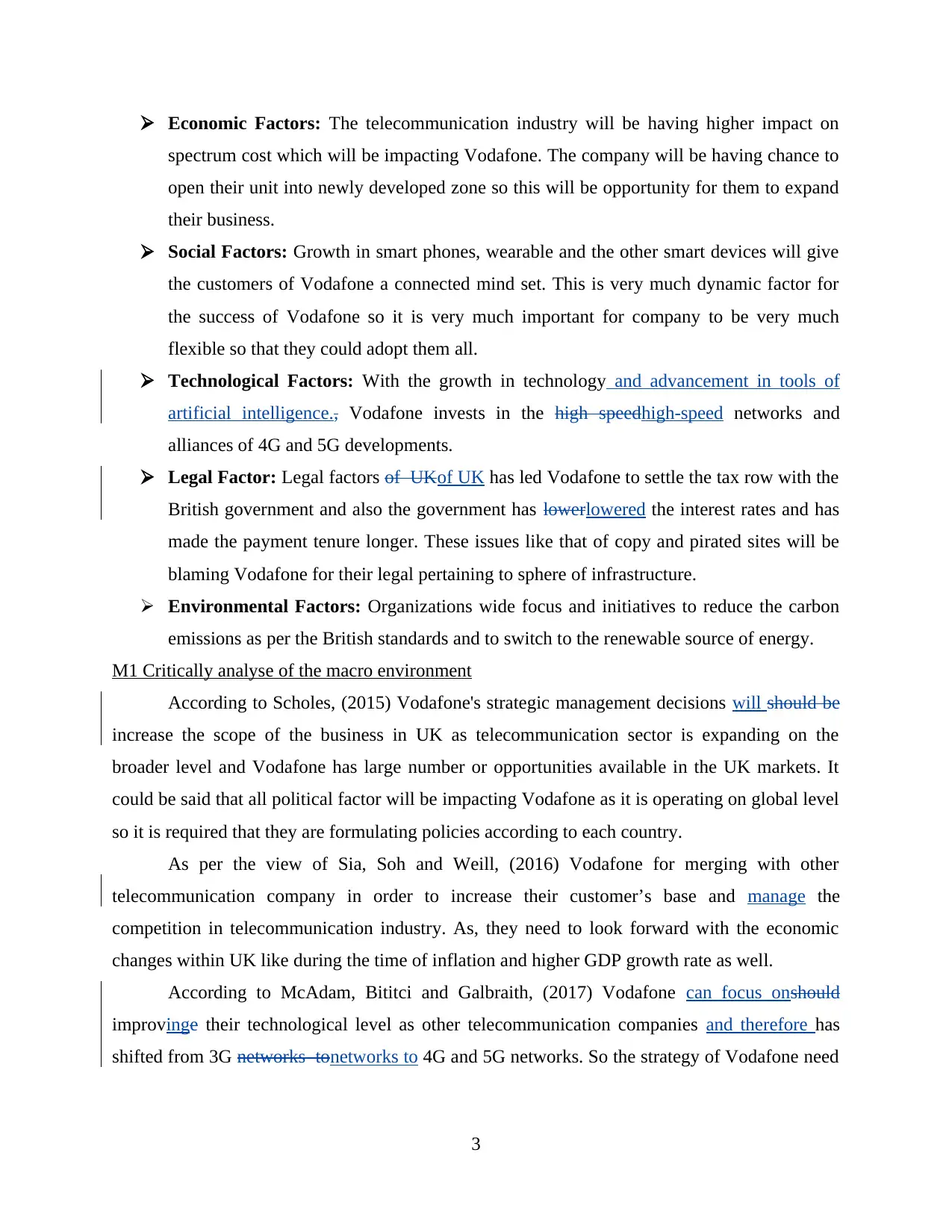
Economic Factors: The telecommunication industry will be having higher impact on
spectrum cost which will be impacting Vodafone. The company will be having chance to
open their unit into newly developed zone so this will be opportunity for them to expand
their business.
Social Factors: Growth in smart phones, wearable and the other smart devices will give
the customers of Vodafone a connected mind set. This is very much dynamic factor for
the success of Vodafone so it is very much important for company to be very much
flexible so that they could adopt them all.
Technological Factors: With the growth in technology and advancement in tools of
artificial intelligence., Vodafone invests in the high speedhigh-speed networks and
alliances of 4G and 5G developments.
Legal Factor: Legal factors of UKof UK has led Vodafone to settle the tax row with the
British government and also the government has lowerlowered the interest rates and has
made the payment tenure longer. These issues like that of copy and pirated sites will be
blaming Vodafone for their legal pertaining to sphere of infrastructure.
Environmental Factors: Organizations wide focus and initiatives to reduce the carbon
emissions as per the British standards and to switch to the renewable source of energy.
M1 Critically analyse of the macro environment
According to Scholes, (2015) Vodafone's strategic management decisions will should be
increase the scope of the business in UK as telecommunication sector is expanding on the
broader level and Vodafone has large number or opportunities available in the UK markets. It
could be said that all political factor will be impacting Vodafone as it is operating on global level
so it is required that they are formulating policies according to each country.
As per the view of Sia, Soh and Weill, (2016) Vodafone for merging with other
telecommunication company in order to increase their customer’s base and manage the
competition in telecommunication industry. As, they need to look forward with the economic
changes within UK like during the time of inflation and higher GDP growth rate as well.
According to McAdam, Bititci and Galbraith, (2017) Vodafone can focus onshould
improvinge their technological level as other telecommunication companies and therefore has
shifted from 3G networks tonetworks to 4G and 5G networks. So the strategy of Vodafone need
3
spectrum cost which will be impacting Vodafone. The company will be having chance to
open their unit into newly developed zone so this will be opportunity for them to expand
their business.
Social Factors: Growth in smart phones, wearable and the other smart devices will give
the customers of Vodafone a connected mind set. This is very much dynamic factor for
the success of Vodafone so it is very much important for company to be very much
flexible so that they could adopt them all.
Technological Factors: With the growth in technology and advancement in tools of
artificial intelligence., Vodafone invests in the high speedhigh-speed networks and
alliances of 4G and 5G developments.
Legal Factor: Legal factors of UKof UK has led Vodafone to settle the tax row with the
British government and also the government has lowerlowered the interest rates and has
made the payment tenure longer. These issues like that of copy and pirated sites will be
blaming Vodafone for their legal pertaining to sphere of infrastructure.
Environmental Factors: Organizations wide focus and initiatives to reduce the carbon
emissions as per the British standards and to switch to the renewable source of energy.
M1 Critically analyse of the macro environment
According to Scholes, (2015) Vodafone's strategic management decisions will should be
increase the scope of the business in UK as telecommunication sector is expanding on the
broader level and Vodafone has large number or opportunities available in the UK markets. It
could be said that all political factor will be impacting Vodafone as it is operating on global level
so it is required that they are formulating policies according to each country.
As per the view of Sia, Soh and Weill, (2016) Vodafone for merging with other
telecommunication company in order to increase their customer’s base and manage the
competition in telecommunication industry. As, they need to look forward with the economic
changes within UK like during the time of inflation and higher GDP growth rate as well.
According to McAdam, Bititci and Galbraith, (2017) Vodafone can focus onshould
improvinge their technological level as other telecommunication companies and therefore has
shifted from 3G networks tonetworks to 4G and 5G networks. So the strategy of Vodafone need
3
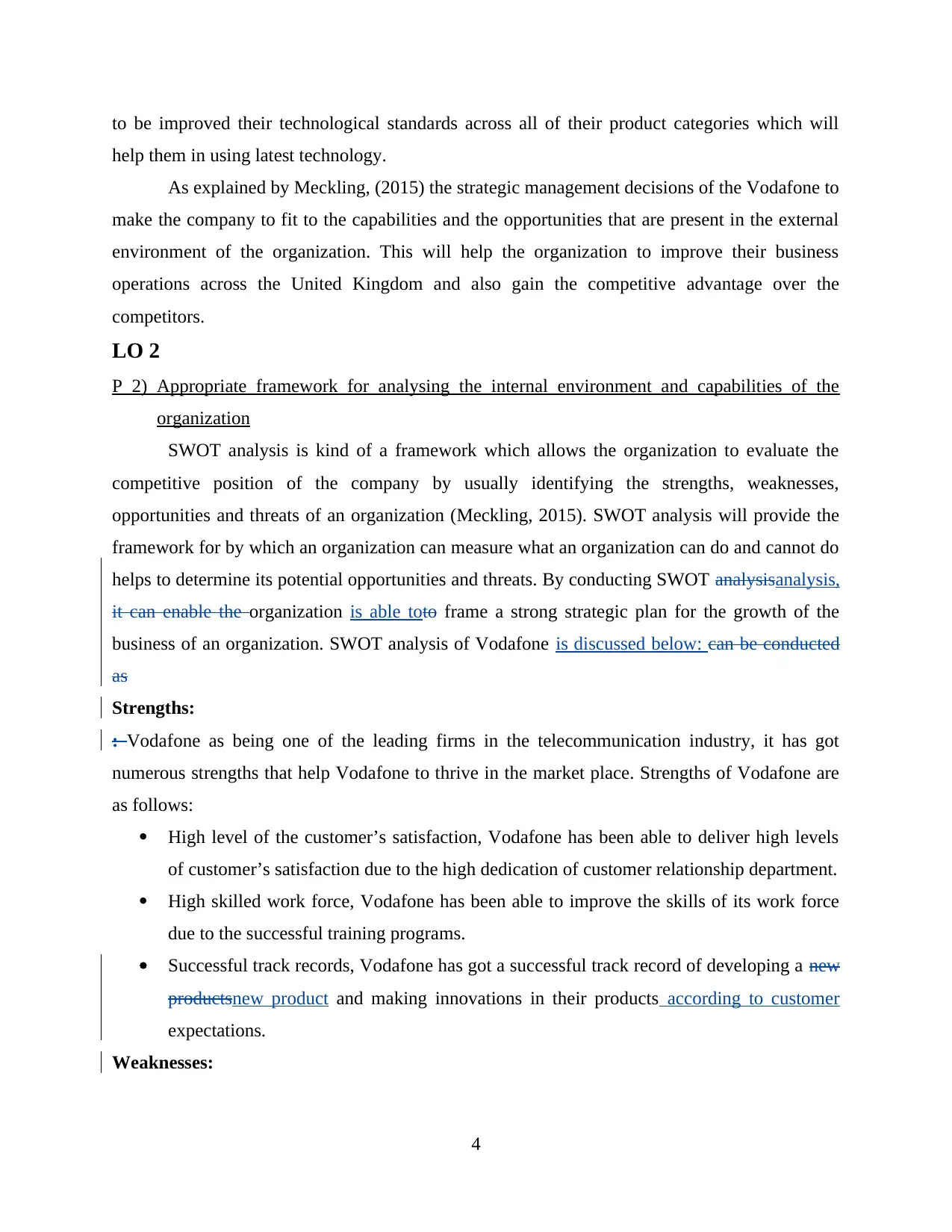
to be improved their technological standards across all of their product categories which will
help them in using latest technology.
As explained by Meckling, (2015) the strategic management decisions of the Vodafone to
make the company to fit to the capabilities and the opportunities that are present in the external
environment of the organization. This will help the organization to improve their business
operations across the United Kingdom and also gain the competitive advantage over the
competitors.
LO 2
P 2) Appropriate framework for analysing the internal environment and capabilities of the
organization
SWOT analysis is kind of a framework which allows the organization to evaluate the
competitive position of the company by usually identifying the strengths, weaknesses,
opportunities and threats of an organization (Meckling, 2015). SWOT analysis will provide the
framework for by which an organization can measure what an organization can do and cannot do
helps to determine its potential opportunities and threats. By conducting SWOT analysisanalysis,
it can enable the organization is able toto frame a strong strategic plan for the growth of the
business of an organization. SWOT analysis of Vodafone is discussed below: can be conducted
as
Strengths:
: Vodafone as being one of the leading firms in the telecommunication industry, it has got
numerous strengths that help Vodafone to thrive in the market place. Strengths of Vodafone are
as follows:
High level of the customer’s satisfaction, Vodafone has been able to deliver high levels
of customer’s satisfaction due to the high dedication of customer relationship department.
High skilled work force, Vodafone has been able to improve the skills of its work force
due to the successful training programs.
Successful track records, Vodafone has got a successful track record of developing a new
productsnew product and making innovations in their products according to customer
expectations.
Weaknesses:
4
help them in using latest technology.
As explained by Meckling, (2015) the strategic management decisions of the Vodafone to
make the company to fit to the capabilities and the opportunities that are present in the external
environment of the organization. This will help the organization to improve their business
operations across the United Kingdom and also gain the competitive advantage over the
competitors.
LO 2
P 2) Appropriate framework for analysing the internal environment and capabilities of the
organization
SWOT analysis is kind of a framework which allows the organization to evaluate the
competitive position of the company by usually identifying the strengths, weaknesses,
opportunities and threats of an organization (Meckling, 2015). SWOT analysis will provide the
framework for by which an organization can measure what an organization can do and cannot do
helps to determine its potential opportunities and threats. By conducting SWOT analysisanalysis,
it can enable the organization is able toto frame a strong strategic plan for the growth of the
business of an organization. SWOT analysis of Vodafone is discussed below: can be conducted
as
Strengths:
: Vodafone as being one of the leading firms in the telecommunication industry, it has got
numerous strengths that help Vodafone to thrive in the market place. Strengths of Vodafone are
as follows:
High level of the customer’s satisfaction, Vodafone has been able to deliver high levels
of customer’s satisfaction due to the high dedication of customer relationship department.
High skilled work force, Vodafone has been able to improve the skills of its work force
due to the successful training programs.
Successful track records, Vodafone has got a successful track record of developing a new
productsnew product and making innovations in their products according to customer
expectations.
Weaknesses:
4
⊘ This is a preview!⊘
Do you want full access?
Subscribe today to unlock all pages.

Trusted by 1+ million students worldwide

: Weaknesses of Vodafone include which Vodafone can improve upon by managing strategic
decision on the basis of business operations.
Vodafone has got limited success outside the core business of an organization.
The firm lacks control over uncertain or Vodafone has not been able to tackle the new
challenges in the changing market.
Vodafone lacks has not been able to get integrationed with firm that of different are
different in culture which denotes ineffectiveness in services with regard to diversity.
Vodafone has weaknesses of product demand forecasting which resulted in the
missing of the new opportunities in the markets. Vodafone is also having very weaker
performance within other market of Europe which is regarded to as one of its
weaknesses.
Lack of financial planning which impact cost effectiveness of business operations.
Opportunities: Various opportunities as per internal strength and external dynamics are
available to Vodafone which are stated below: are
Low inflation rate is s are an opportunity for the company as it will bring more stability in the
market. Low inflation rates will also allow the organization to credit lower interest rates to the
customers.
New trends in the consumer behaviour are opening new markets and provide an
opportunity for Vodafone to come up with new product categories like changes in talk
plans or internet packs, etc.
New taxation policies will significantly change the dynamics of business impact to
operations of the business which will provide Vodafone an opportunity to increase its
profitability and focus on cost effectiveness.
Threats:
As company is operating in different countries it results in the currency fluctuations due
to this Vodafone will need to every time change their policies and is regarded to as threat.
The Impact of Brexit and regular devaluation of pound will be regarded to as threat for
company which they need to plan so that they could easily overcome these situations.
Changing buying behaviours of the consumers is also posing a threat to the organization
like reduction in demand, shift of buyers, etc.
5
decision on the basis of business operations.
Vodafone has got limited success outside the core business of an organization.
The firm lacks control over uncertain or Vodafone has not been able to tackle the new
challenges in the changing market.
Vodafone lacks has not been able to get integrationed with firm that of different are
different in culture which denotes ineffectiveness in services with regard to diversity.
Vodafone has weaknesses of product demand forecasting which resulted in the
missing of the new opportunities in the markets. Vodafone is also having very weaker
performance within other market of Europe which is regarded to as one of its
weaknesses.
Lack of financial planning which impact cost effectiveness of business operations.
Opportunities: Various opportunities as per internal strength and external dynamics are
available to Vodafone which are stated below: are
Low inflation rate is s are an opportunity for the company as it will bring more stability in the
market. Low inflation rates will also allow the organization to credit lower interest rates to the
customers.
New trends in the consumer behaviour are opening new markets and provide an
opportunity for Vodafone to come up with new product categories like changes in talk
plans or internet packs, etc.
New taxation policies will significantly change the dynamics of business impact to
operations of the business which will provide Vodafone an opportunity to increase its
profitability and focus on cost effectiveness.
Threats:
As company is operating in different countries it results in the currency fluctuations due
to this Vodafone will need to every time change their policies and is regarded to as threat.
The Impact of Brexit and regular devaluation of pound will be regarded to as threat for
company which they need to plan so that they could easily overcome these situations.
Changing buying behaviours of the consumers is also posing a threat to the organization
like reduction in demand, shift of buyers, etc.
5
Paraphrase This Document
Need a fresh take? Get an instant paraphrase of this document with our AI Paraphraser
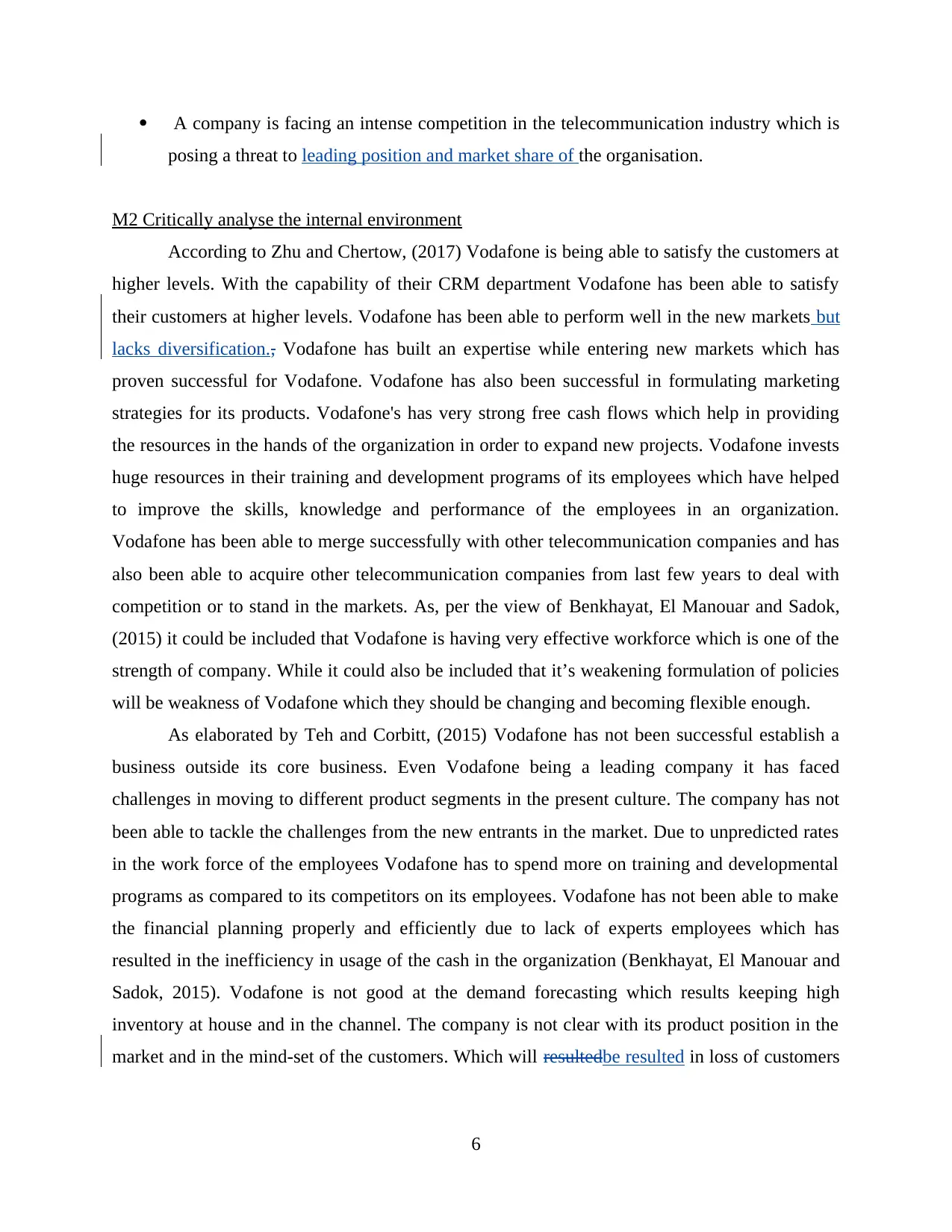
A company is facing an intense competition in the telecommunication industry which is
posing a threat to leading position and market share of the organisation.
M2 Critically analyse the internal environment
According to Zhu and Chertow, (2017) Vodafone is being able to satisfy the customers at
higher levels. With the capability of their CRM department Vodafone has been able to satisfy
their customers at higher levels. Vodafone has been able to perform well in the new markets but
lacks diversification., Vodafone has built an expertise while entering new markets which has
proven successful for Vodafone. Vodafone has also been successful in formulating marketing
strategies for its products. Vodafone's has very strong free cash flows which help in providing
the resources in the hands of the organization in order to expand new projects. Vodafone invests
huge resources in their training and development programs of its employees which have helped
to improve the skills, knowledge and performance of the employees in an organization.
Vodafone has been able to merge successfully with other telecommunication companies and has
also been able to acquire other telecommunication companies from last few years to deal with
competition or to stand in the markets. As, per the view of Benkhayat, El Manouar and Sadok,
(2015) it could be included that Vodafone is having very effective workforce which is one of the
strength of company. While it could also be included that it’s weakening formulation of policies
will be weakness of Vodafone which they should be changing and becoming flexible enough.
As elaborated by Teh and Corbitt, (2015) Vodafone has not been successful establish a
business outside its core business. Even Vodafone being a leading company it has faced
challenges in moving to different product segments in the present culture. The company has not
been able to tackle the challenges from the new entrants in the market. Due to unpredicted rates
in the work force of the employees Vodafone has to spend more on training and developmental
programs as compared to its competitors on its employees. Vodafone has not been able to make
the financial planning properly and efficiently due to lack of experts employees which has
resulted in the inefficiency in usage of the cash in the organization (Benkhayat, El Manouar and
Sadok, 2015). Vodafone is not good at the demand forecasting which results keeping high
inventory at house and in the channel. The company is not clear with its product position in the
market and in the mind-set of the customers. Which will resultedbe resulted in loss of customers
6
posing a threat to leading position and market share of the organisation.
M2 Critically analyse the internal environment
According to Zhu and Chertow, (2017) Vodafone is being able to satisfy the customers at
higher levels. With the capability of their CRM department Vodafone has been able to satisfy
their customers at higher levels. Vodafone has been able to perform well in the new markets but
lacks diversification., Vodafone has built an expertise while entering new markets which has
proven successful for Vodafone. Vodafone has also been successful in formulating marketing
strategies for its products. Vodafone's has very strong free cash flows which help in providing
the resources in the hands of the organization in order to expand new projects. Vodafone invests
huge resources in their training and development programs of its employees which have helped
to improve the skills, knowledge and performance of the employees in an organization.
Vodafone has been able to merge successfully with other telecommunication companies and has
also been able to acquire other telecommunication companies from last few years to deal with
competition or to stand in the markets. As, per the view of Benkhayat, El Manouar and Sadok,
(2015) it could be included that Vodafone is having very effective workforce which is one of the
strength of company. While it could also be included that it’s weakening formulation of policies
will be weakness of Vodafone which they should be changing and becoming flexible enough.
As elaborated by Teh and Corbitt, (2015) Vodafone has not been successful establish a
business outside its core business. Even Vodafone being a leading company it has faced
challenges in moving to different product segments in the present culture. The company has not
been able to tackle the challenges from the new entrants in the market. Due to unpredicted rates
in the work force of the employees Vodafone has to spend more on training and developmental
programs as compared to its competitors on its employees. Vodafone has not been able to make
the financial planning properly and efficiently due to lack of experts employees which has
resulted in the inefficiency in usage of the cash in the organization (Benkhayat, El Manouar and
Sadok, 2015). Vodafone is not good at the demand forecasting which results keeping high
inventory at house and in the channel. The company is not clear with its product position in the
market and in the mind-set of the customers. Which will resultedbe resulted in loss of customers
6

for an organisation and also it will make Vodafone difficult to change the mind-set of the
customers in the future.
LO 3
P 3) Porter Five forces model
Porter’s five forces model is the important tool in order to understand the various forces
which shape the competition within the industry (Porters generic strategies, 2018). Porter’s five
forces are also useful in making the adjustments in organization's current strategy in order to suit
to the competitive environment and also to improve the potential profit of the organization
(Cubas‐Díaz and Martínez Sedano, 2018). Porter’s five forces framework acts as tool for to
analyse the competition of the business in the industry. Porter’s Five Forces framework will help
to determine the competitive environment of has effect on the profitability of an. According to
the Porter there are five forces which an has to face while operating a business which includes
1. Threat of substitutes
2. Threat of new entrants
3. Bargaining power of buyers
4. Bargaining power of suppliers and
5. Industrial rivalry.
7
customers in the future.
LO 3
P 3) Porter Five forces model
Porter’s five forces model is the important tool in order to understand the various forces
which shape the competition within the industry (Porters generic strategies, 2018). Porter’s five
forces are also useful in making the adjustments in organization's current strategy in order to suit
to the competitive environment and also to improve the potential profit of the organization
(Cubas‐Díaz and Martínez Sedano, 2018). Porter’s five forces framework acts as tool for to
analyse the competition of the business in the industry. Porter’s Five Forces framework will help
to determine the competitive environment of has effect on the profitability of an. According to
the Porter there are five forces which an has to face while operating a business which includes
1. Threat of substitutes
2. Threat of new entrants
3. Bargaining power of buyers
4. Bargaining power of suppliers and
5. Industrial rivalry.
7
⊘ This is a preview!⊘
Do you want full access?
Subscribe today to unlock all pages.

Trusted by 1+ million students worldwide
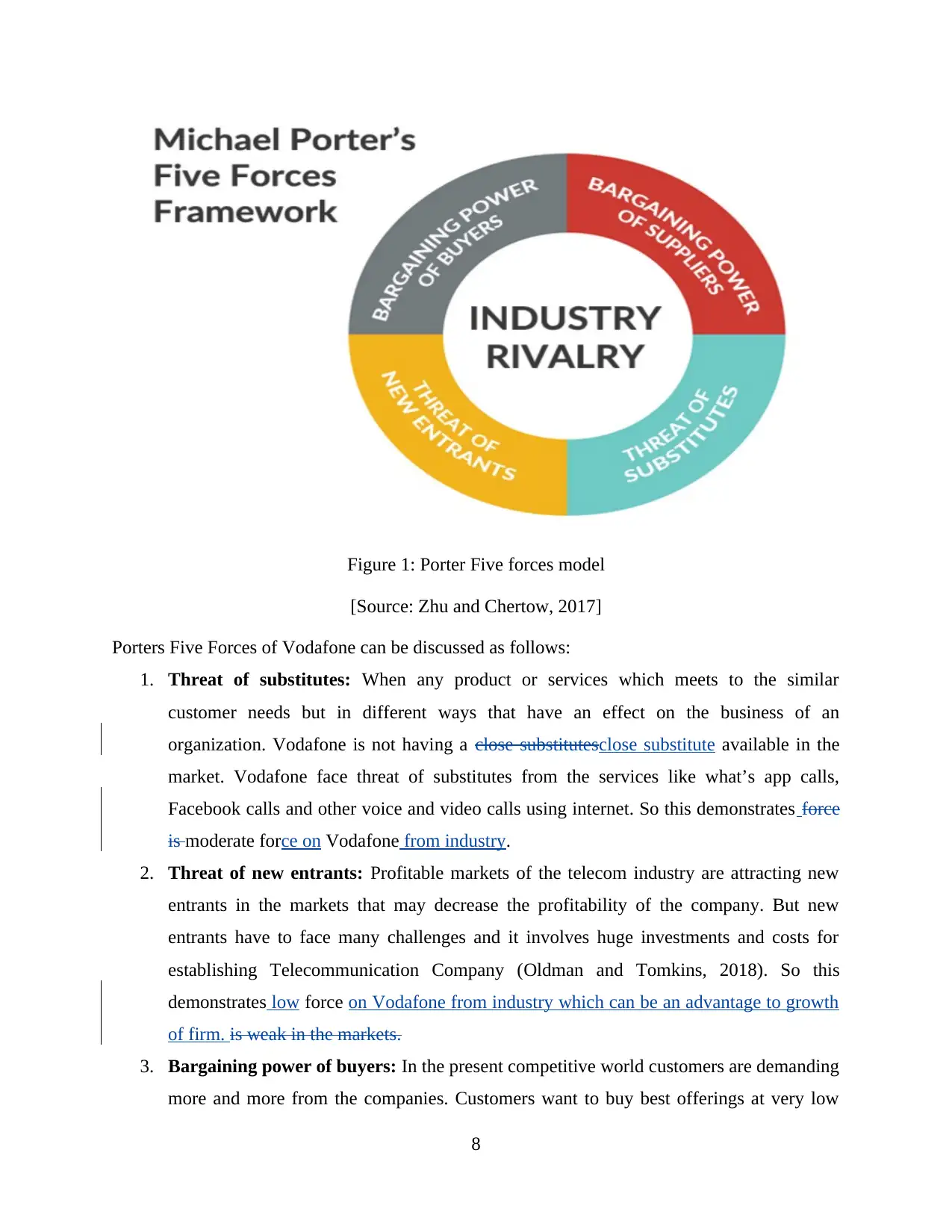
Figure 1: Porter Five forces model
[Source: Zhu and Chertow, 2017]
Porters Five Forces of Vodafone can be discussed as follows:
1. Threat of substitutes: When any product or services which meets to the similar
customer needs but in different ways that have an effect on the business of an
organization. Vodafone is not having a close substitutesclose substitute available in the
market. Vodafone face threat of substitutes from the services like what’s app calls,
Facebook calls and other voice and video calls using internet. So this demonstrates force
is moderate force on Vodafone from industry.
2. Threat of new entrants: Profitable markets of the telecom industry are attracting new
entrants in the markets that may decrease the profitability of the company. But new
entrants have to face many challenges and it involves huge investments and costs for
establishing Telecommunication Company (Oldman and Tomkins, 2018). So this
demonstrates low force on Vodafone from industry which can be an advantage to growth
of firm. is weak in the markets.
3. Bargaining power of buyers: In the present competitive world customers are demanding
more and more from the companies. Customers want to buy best offerings at very low
8
[Source: Zhu and Chertow, 2017]
Porters Five Forces of Vodafone can be discussed as follows:
1. Threat of substitutes: When any product or services which meets to the similar
customer needs but in different ways that have an effect on the business of an
organization. Vodafone is not having a close substitutesclose substitute available in the
market. Vodafone face threat of substitutes from the services like what’s app calls,
Facebook calls and other voice and video calls using internet. So this demonstrates force
is moderate force on Vodafone from industry.
2. Threat of new entrants: Profitable markets of the telecom industry are attracting new
entrants in the markets that may decrease the profitability of the company. But new
entrants have to face many challenges and it involves huge investments and costs for
establishing Telecommunication Company (Oldman and Tomkins, 2018). So this
demonstrates low force on Vodafone from industry which can be an advantage to growth
of firm. is weak in the markets.
3. Bargaining power of buyers: In the present competitive world customers are demanding
more and more from the companies. Customers want to buy best offerings at very low
8
Paraphrase This Document
Need a fresh take? Get an instant paraphrase of this document with our AI Paraphraser
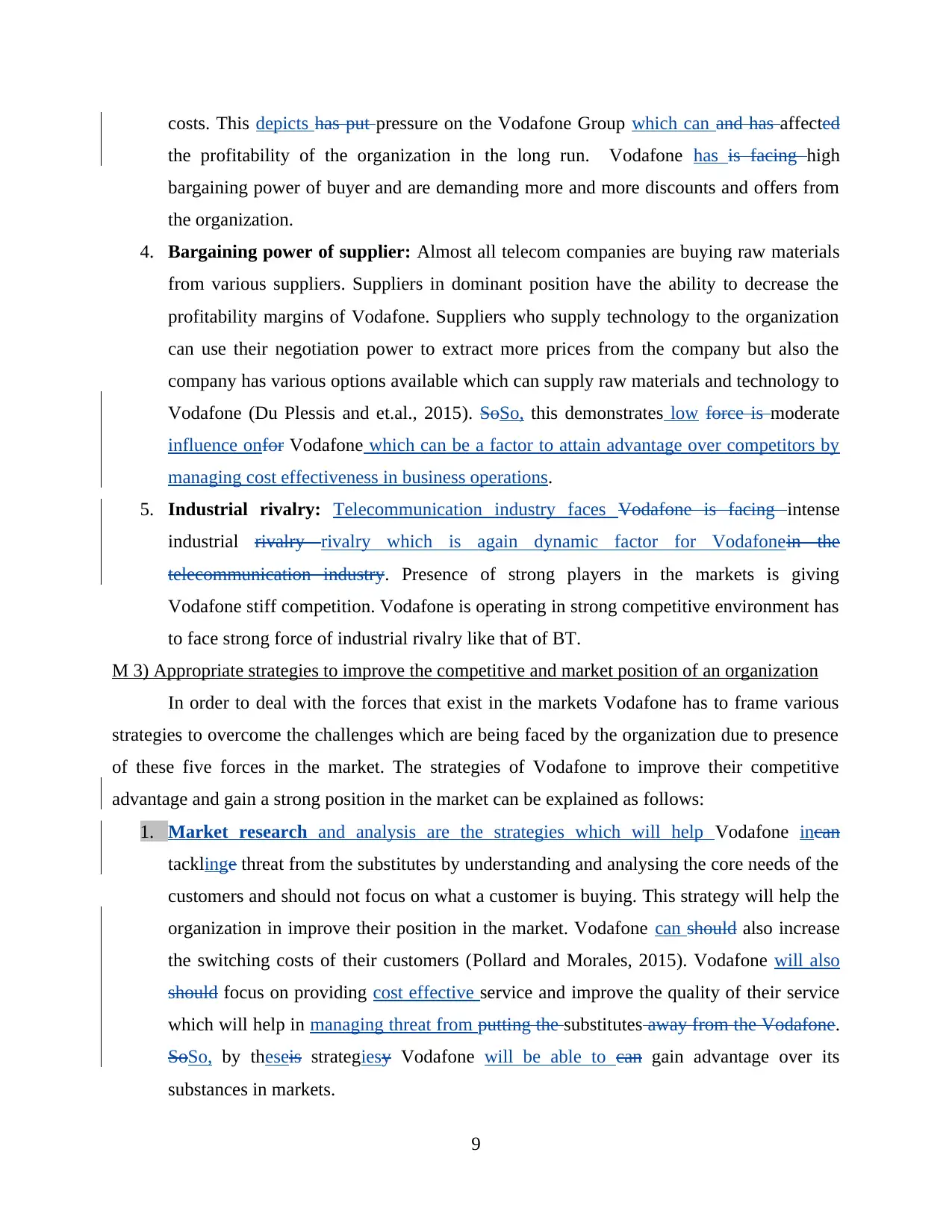
costs. This depicts has put pressure on the Vodafone Group which can and has affected
the profitability of the organization in the long run. Vodafone has is facing high
bargaining power of buyer and are demanding more and more discounts and offers from
the organization.
4. Bargaining power of supplier: Almost all telecom companies are buying raw materials
from various suppliers. Suppliers in dominant position have the ability to decrease the
profitability margins of Vodafone. Suppliers who supply technology to the organization
can use their negotiation power to extract more prices from the company but also the
company has various options available which can supply raw materials and technology to
Vodafone (Du Plessis and et.al., 2015). SoSo, this demonstrates low force is moderate
influence onfor Vodafone which can be a factor to attain advantage over competitors by
managing cost effectiveness in business operations.
5. Industrial rivalry: Telecommunication industry faces Vodafone is facing intense
industrial rivalry rivalry which is again dynamic factor for Vodafonein the
telecommunication industry. Presence of strong players in the markets is giving
Vodafone stiff competition. Vodafone is operating in strong competitive environment has
to face strong force of industrial rivalry like that of BT.
M 3) Appropriate strategies to improve the competitive and market position of an organization
In order to deal with the forces that exist in the markets Vodafone has to frame various
strategies to overcome the challenges which are being faced by the organization due to presence
of these five forces in the market. The strategies of Vodafone to improve their competitive
advantage and gain a strong position in the market can be explained as follows:
1. Market research and analysis are the strategies which will help Vodafone incan
tacklinge threat from the substitutes by understanding and analysing the core needs of the
customers and should not focus on what a customer is buying. This strategy will help the
organization in improve their position in the market. Vodafone can should also increase
the switching costs of their customers (Pollard and Morales, 2015). Vodafone will also
should focus on providing cost effective service and improve the quality of their service
which will help in managing threat from putting the substitutes away from the Vodafone.
SoSo, by theseis strategiesy Vodafone will be able to can gain advantage over its
substances in markets.
9
the profitability of the organization in the long run. Vodafone has is facing high
bargaining power of buyer and are demanding more and more discounts and offers from
the organization.
4. Bargaining power of supplier: Almost all telecom companies are buying raw materials
from various suppliers. Suppliers in dominant position have the ability to decrease the
profitability margins of Vodafone. Suppliers who supply technology to the organization
can use their negotiation power to extract more prices from the company but also the
company has various options available which can supply raw materials and technology to
Vodafone (Du Plessis and et.al., 2015). SoSo, this demonstrates low force is moderate
influence onfor Vodafone which can be a factor to attain advantage over competitors by
managing cost effectiveness in business operations.
5. Industrial rivalry: Telecommunication industry faces Vodafone is facing intense
industrial rivalry rivalry which is again dynamic factor for Vodafonein the
telecommunication industry. Presence of strong players in the markets is giving
Vodafone stiff competition. Vodafone is operating in strong competitive environment has
to face strong force of industrial rivalry like that of BT.
M 3) Appropriate strategies to improve the competitive and market position of an organization
In order to deal with the forces that exist in the markets Vodafone has to frame various
strategies to overcome the challenges which are being faced by the organization due to presence
of these five forces in the market. The strategies of Vodafone to improve their competitive
advantage and gain a strong position in the market can be explained as follows:
1. Market research and analysis are the strategies which will help Vodafone incan
tacklinge threat from the substitutes by understanding and analysing the core needs of the
customers and should not focus on what a customer is buying. This strategy will help the
organization in improve their position in the market. Vodafone can should also increase
the switching costs of their customers (Pollard and Morales, 2015). Vodafone will also
should focus on providing cost effective service and improve the quality of their service
which will help in managing threat from putting the substitutes away from the Vodafone.
SoSo, by theseis strategiesy Vodafone will be able to can gain advantage over its
substances in markets.
9
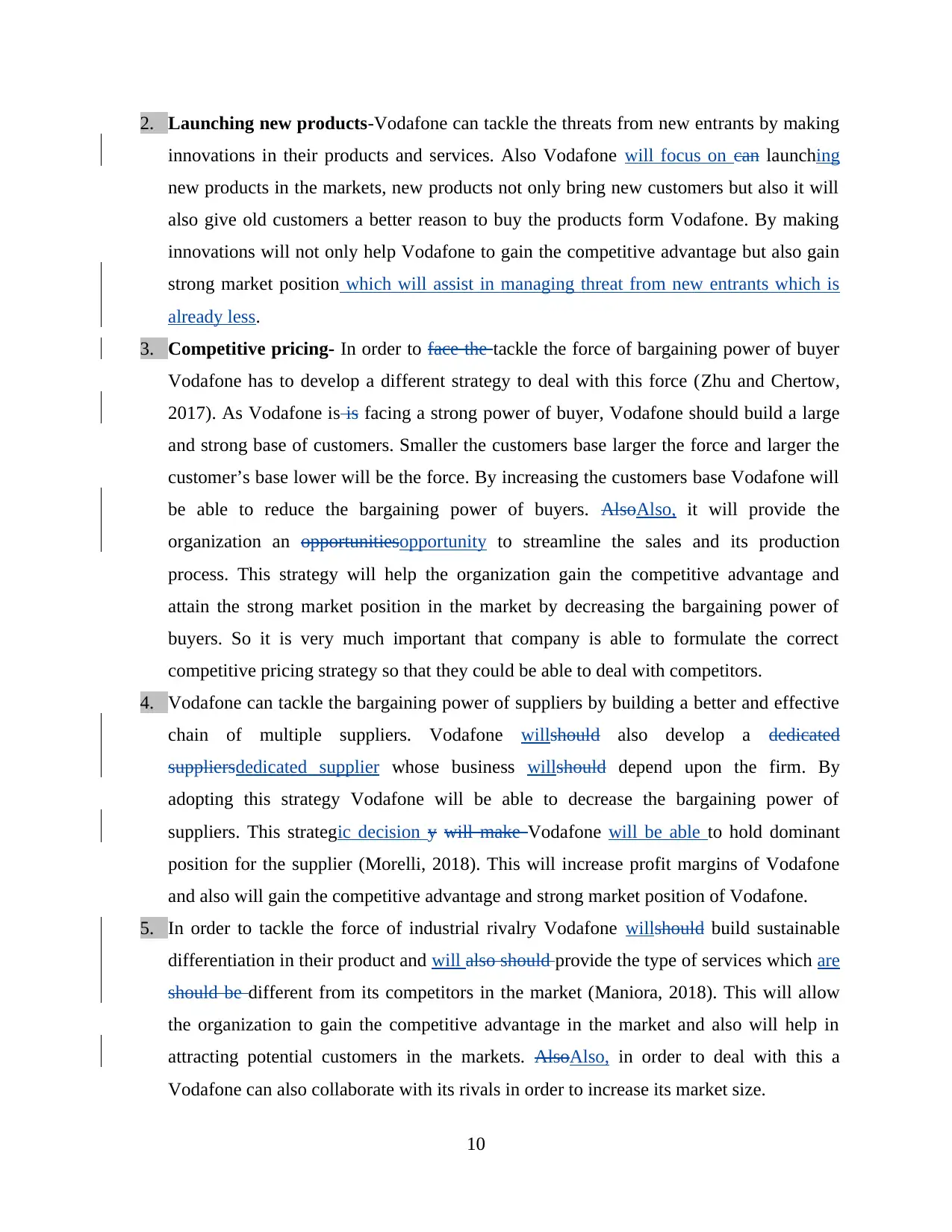
2. Launching new products-Vodafone can tackle the threats from new entrants by making
innovations in their products and services. Also Vodafone will focus on can launching
new products in the markets, new products not only bring new customers but also it will
also give old customers a better reason to buy the products form Vodafone. By making
innovations will not only help Vodafone to gain the competitive advantage but also gain
strong market position which will assist in managing threat from new entrants which is
already less.
3. Competitive pricing- In order to face the tackle the force of bargaining power of buyer
Vodafone has to develop a different strategy to deal with this force (Zhu and Chertow,
2017). As Vodafone is is facing a strong power of buyer, Vodafone should build a large
and strong base of customers. Smaller the customers base larger the force and larger the
customer’s base lower will be the force. By increasing the customers base Vodafone will
be able to reduce the bargaining power of buyers. AlsoAlso, it will provide the
organization an opportunitiesopportunity to streamline the sales and its production
process. This strategy will help the organization gain the competitive advantage and
attain the strong market position in the market by decreasing the bargaining power of
buyers. So it is very much important that company is able to formulate the correct
competitive pricing strategy so that they could be able to deal with competitors.
4. Vodafone can tackle the bargaining power of suppliers by building a better and effective
chain of multiple suppliers. Vodafone willshould also develop a dedicated
suppliersdedicated supplier whose business willshould depend upon the firm. By
adopting this strategy Vodafone will be able to decrease the bargaining power of
suppliers. This strategic decision y will make Vodafone will be able to hold dominant
position for the supplier (Morelli, 2018). This will increase profit margins of Vodafone
and also will gain the competitive advantage and strong market position of Vodafone.
5. In order to tackle the force of industrial rivalry Vodafone willshould build sustainable
differentiation in their product and will also should provide the type of services which are
should be different from its competitors in the market (Maniora, 2018). This will allow
the organization to gain the competitive advantage in the market and also will help in
attracting potential customers in the markets. AlsoAlso, in order to deal with this a
Vodafone can also collaborate with its rivals in order to increase its market size.
10
innovations in their products and services. Also Vodafone will focus on can launching
new products in the markets, new products not only bring new customers but also it will
also give old customers a better reason to buy the products form Vodafone. By making
innovations will not only help Vodafone to gain the competitive advantage but also gain
strong market position which will assist in managing threat from new entrants which is
already less.
3. Competitive pricing- In order to face the tackle the force of bargaining power of buyer
Vodafone has to develop a different strategy to deal with this force (Zhu and Chertow,
2017). As Vodafone is is facing a strong power of buyer, Vodafone should build a large
and strong base of customers. Smaller the customers base larger the force and larger the
customer’s base lower will be the force. By increasing the customers base Vodafone will
be able to reduce the bargaining power of buyers. AlsoAlso, it will provide the
organization an opportunitiesopportunity to streamline the sales and its production
process. This strategy will help the organization gain the competitive advantage and
attain the strong market position in the market by decreasing the bargaining power of
buyers. So it is very much important that company is able to formulate the correct
competitive pricing strategy so that they could be able to deal with competitors.
4. Vodafone can tackle the bargaining power of suppliers by building a better and effective
chain of multiple suppliers. Vodafone willshould also develop a dedicated
suppliersdedicated supplier whose business willshould depend upon the firm. By
adopting this strategy Vodafone will be able to decrease the bargaining power of
suppliers. This strategic decision y will make Vodafone will be able to hold dominant
position for the supplier (Morelli, 2018). This will increase profit margins of Vodafone
and also will gain the competitive advantage and strong market position of Vodafone.
5. In order to tackle the force of industrial rivalry Vodafone willshould build sustainable
differentiation in their product and will also should provide the type of services which are
should be different from its competitors in the market (Maniora, 2018). This will allow
the organization to gain the competitive advantage in the market and also will help in
attracting potential customers in the markets. AlsoAlso, in order to deal with this a
Vodafone can also collaborate with its rivals in order to increase its market size.
10
⊘ This is a preview!⊘
Do you want full access?
Subscribe today to unlock all pages.

Trusted by 1+ million students worldwide
1 out of 21
Related Documents
Your All-in-One AI-Powered Toolkit for Academic Success.
+13062052269
info@desklib.com
Available 24*7 on WhatsApp / Email
![[object Object]](/_next/static/media/star-bottom.7253800d.svg)
Unlock your academic potential
Copyright © 2020–2025 A2Z Services. All Rights Reserved. Developed and managed by ZUCOL.





